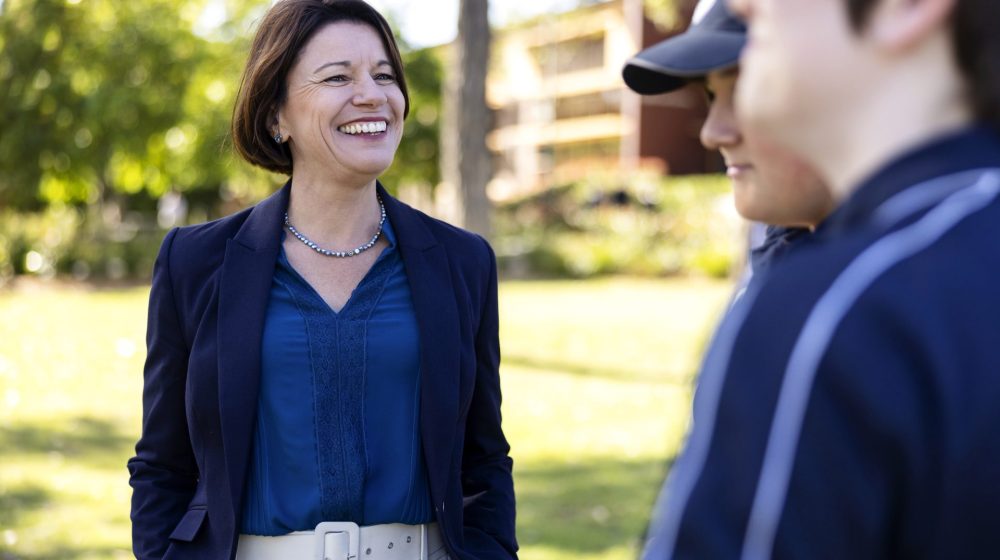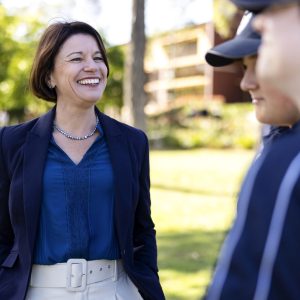Published on February 3, 2023
Walking onto the HVGS you can’t help but feel connected to nature and feel a sense of openness and space. The dominant feature of our “green corridor” from the main carpark to the Cameron Centre are the tall gumtrees that draw an abundance of birdlife. Students moving around our campus don’t feel “boxed in”, but rather can always find a space to move, breath and play. I have seen staff walk and talk around the campus with worried and anxious students as means of helping them find a place of centre and calmness. And it works because our campus is designed for it – to support the physical, emotional and mental wellbeing of our students and staff.
Designing for a bigger purpose – for the learning and flourishing we want to see happen – is key in schools. Our buildings are not tall because we want the tree line to draw the eye of our students. Our fields are big because we want students to be able to run. Our classrooms have many windows, so nature is drawn into the learning spaces. We want our students to be inspired by what is outside the classroom as well as what is happening in the classroom.
Beyond our gates, we also have two unique spaces of inspiration – our School Farm on Pedder Road and our HVGS rowing facility in Duckenfield. We took our new staff to both spaces this year and they were in awe and inspired by our HVGS spaces there and on campus.
“This year HVGS is 33 years old, and as we look ahead to how we can enhance our campus, we need to stay true to who we are as a school and what is unique about our spaces. In addition, we need to consider the sustainability of our spaces into the future.”
In July 2022 the CSIRO published their “once in a decade report” (you can access it here) on future global megatrends. The graphic below. Adapting to climate change and working towards being “leaner, cleaner and greener” are key megatrends they identify as crucial for the future. At HVGS we need to consider our contribution to caring for our environment and enabling sustainability to be a key imperative driving our strategic vision and how we go about realising that vision.

Image 1: CSIRO identified Global Megatrends
However, addressing both trends requires a complex and nuanced understanding of what it means to be a truly sustainable organization. One of the most powerful models for thinking about sustainability is The Compass Model of Sustainability. This model identifies a four-pronged approach to sustainability that is organised around a compass. Any pursuit of sustainable initiatives needs to find a balance across these four dimensions: a truly sustainable organisation considers environmental, economic, society and culture and wellbeing. Sustainability then, is about looking after our beautiful green spaces (like the ones we have at HVGS), ensuring our communities and organisations are financially sustainable into the future, and safeguarding wellbeing and the society and culture at the heart of an organization or community. It requires systems thinking; looking at any change process through the lens of the potential impact of change on all four parts of the compass and ensuring all four parts are working effectively within the system.

Image 2: The Compass Model of Sustainability.
To return to our school and our physical environment. This year we are embarking on three key projects:
- The refurbishment of the P5 Junior School bathrooms. After extensive consultation last year (including with our students) we realised the P5 bathrooms were not supporting the wellbeing of our students (there were ventilation challenges and they were dark). We wanted them to be open, light and welcoming for students. We set about working with architects to redesign the bathrooms. Learning, positive connections and student safety was placed at the heart of the design. We focused on creating a space that uses warm colours, better lighting and that brings the wash basins out into the centre of the space. We are removing walls and instead ensuring cubicles have high walls and high doors but make it easier for students to call out for help or support if they need it. A greater line of sight for staff ensures better monitoring of behavior in line with our social norms.
- The refurbishment of our Lecture Theatre. We have the great privilege of a lecture theatre attached to our Weeks Library. However, the theatre is “tired”. Despite being outdated, it is a great space with incredible potential. To be environmentally sustainable we are keeping as much of the Lecture Theatre as we can but bringing it to life again as a warm, inviting and usable space for presentations and performances. We see it as a space we can better use to build connections across the community. It will include a retractable door to the outside to enable “pop up” performances to occur at break and lunch and create a flexible learning space that brings nature in as appropriate.
- Redevelopment our Kindergarten outdoor learning spaces. Outside our Kindergarten classrooms is a wealth of outdoor space and this year we will begin to work with architects on how we design this space to support outdoor learning using natural materials in line with our wonderful bush campus feel.
Enhancing our current spaces is important. Often, we get excited by the new concept, the big new building. From my perspective, waiting for the next big thing can take us away from looking, in a sustainable way, at our current spaces and how we can enhance them with all elements of sustainability in mind. We want to maintain that connection to nature so central to our student wellbeing, we want to ensure our spaces foster the social and cultural connections that are important to us, and that our projects have the hallmarks of fiscal responsibility.


